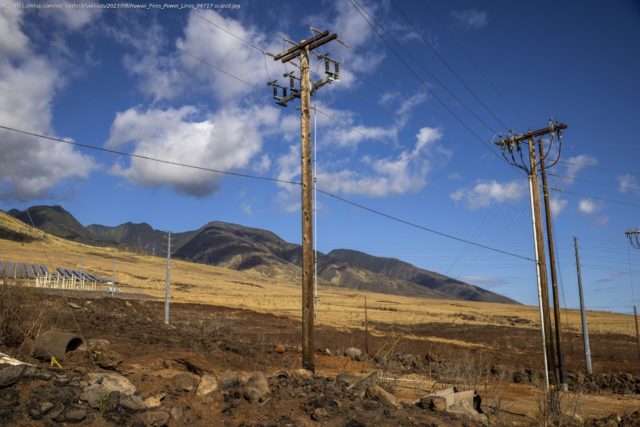In the first moments of the Maui fires, when high winds brought down power poles, slapping electrified wires to the dry grass below, there was a reason the…
In the first moments of the Maui fires, when high winds brought down power poles, slapping electrified wires to the dry grass below, there was a reason the flames erupted all at once in long, neat rows — those wires were bare, uninsulated metal that could spark on contact.
Videos and images analyzed by The Associated Press confirmed those wires were among miles of line that Hawaiian Electric Company. left naked to the weather and often-thick foliage, despite a recent push by utilities in other wildfire- and hurricane-prone areas to cover up their lines or bury them.
Compounding the problem is that many of the utility’s 60,000, mostly wooden power poles, which its own documents described as built to “an obsolete 1960s standard,” were leaning and near the end of their projected lifespan. They were nowhere close to meeting a 2002 national standard that key components of Hawaii’s electrical grid be able to withstand 105 mile per hour winds. A 2019 filing said it had fallen behind in replacing the old wooden poles because of other priorities and warned of a “serious public hazard” if they “failed.”
Google street view images of poles taken before the fire show the bare wire.
It’s “very unlikely” a fully-insulated cable would have sparked and caused a fire in dry vegetation, said Michael Ahern, who retired this month as director of power systems at Worcester Polytechnic Institute in Massachusetts.
Experts who watched videos showing downed power lines agreed wire that was insulated would not have arced and sparked, igniting a line of flame.
A former member of the Hawaii Public Utilities Commission confirmed many of Maui’s wooden power poles were also in poor condition. Jennifer Potter lives in Lahaina and until the end of last year was on the commission, which regulates Hawaiian Electric.
“Even tourists that drive around the island are like, ‘What is that?’ They’re leaning quite significantly because the winds over time literally just pushed them over,” she said. “That obviously is not going to withstand 60, 70 mile per hour winds. So the infrastructure was just not strong enough for this kind of windstorm … The infrastructure itself is just compromised.”
John Morgan, a personal injury and trial attorney in Florida who lives part-time in Maui noticed the same thing. “I could look at the power poles. They were skinny, bending, bowing. The power went out all the time.”
Morgan’s firm is suing Hawaiian Electric on behalf of one person and talking to many more about their rights. The fire came 500 yards within his house.
Sixty percent of the utility poles on West Maui were still down on Aug. 14, according to Hawaiian Electric CEO Shelee Kimura at a media conference — 450 of the 750 poles.
Hawaiian Electric said it is focused on restoring power and wouldn’t say whether the specific power lines involved in the fires were bare or comment on the state of the poles, citing a spate of new lawsuits that seek to hold it responsible for the deadliest U.






